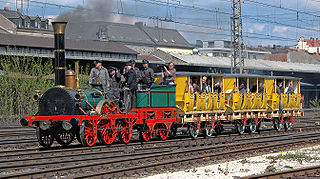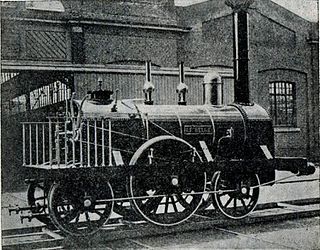
Under the Whyte notation for the classification of steam locomotives by wheel arrangement, 4-4-2 represents a configuration of a four-wheeled leading bogie, four powered and coupled driving wheels, and two trailing wheels supporting part of the weight of the boiler and firebox. This allows a larger firebox and boiler than the 4-4-0 configuration.

Under the Whyte notation for the classification of steam locomotives, 2-2-2 represents the wheel arrangement of two leading wheels on one axle, two powered driving wheels on one axle, and two trailing wheels on one axle. The wheel arrangement both provided more stability and enabled a larger firebox than the earlier 0-2-2 and 2-2-0 types. This configuration was introduced in 1834 on Robert Stephenson's 'Patentee locomotive' but it was later popularly named Jenny Lind, after the Jenny Lind locomotive which in turn was named after the popular singer. They were also sometimes described as Singles, although this name could be used to describe any kind of locomotive with a single pair of driving wheels.

John Cockerill was an English-born industrialist who became a prominent businessman in Belgium. Born at Haslingden, Lancashire, England, he was brought by his father to the Liège region, where he continued the family tradition of building wool-processing machinery. He founded an ironworks named John Cockerill & Cie..

Athus is a part of Aubange city Wallonia and a district of the municipality of Aubange, located in the province of Luxembourg, Belgium.
The Société Franco-Belge was a Franco-Belgian engineering firm that specialised in the construction of railway vehicles and their components and accessories. The company originated in 1859 as the Belgian firm Compagnie Belge pour la Construction de Machines et de Matériels de Chemins de Fer, founded by Charles Evrard. The company expanded its share capital in 1881 forming a new firm Société Anonyme Franco-Belge pour la Construction de Machines et de Matériel de Chemins de Fer and constructed a factory in Raismes (Valenciennes) in the Département Nord in France.

John Cockerill & Cie. was a Belgian iron, steel, and manufacturing company based at Seraing in Liège Province. It was founded in 1825 by English-born industrialist John Cockerill.

The Belgian iron and steel producing company Ougrée-Marihaye was formed in 1835 by the merger of the iron and steel works in Ougrée in Liège Province, and the coal mines of Marihaye. The company merged with the Société anonyme John Cockerill in 1955 to form Cockerill-Ougrée.
Hainaut-Sambre was a Belgian group of steel companies based in the Charleroi region, it was founded in 1955 by the merger of Usine Métallurgiques du Hainaut, and the metal making division of Sambre et Moselle.
John Cockerill, formerly Cockerill Maintenance & Ingénierie (CMI), is a mechanical engineering group headquartered in Seraing, Belgium. It produces machinery for steel plants, industrial heat recovery equipment and boilers, as well as shunting locomotives and military equipment.

The Patentee locomotive was a revolutionary 2-2-2 steam locomotive type introduced by Robert Stephenson and Company in 1833, as an enlargement of their 2-2-0 Planet type. The wheel arrangement of two leading wheels on one axle, two powered driving wheels on one axle, and two trailing wheels on one axle provided more stability and enabled a larger firebox than the earlier 0-2-2 and 2-2-0 types.

Belgium was heavily involved in the early development of railway transport. Belgium was the second country in Europe, after Great Britain, to open a railway and produce locomotives. The first line, between the cities of Brussels and Mechelen opened in 1835. Belgium was the first state in Europe to create a national railway network and the first to possess a nationalised railway system. The network expanded fast as Belgium industrialised, and by the early 20th century was increasingly under state-control. The nationalised railways, under the umbrella organisation National Railway Company of Belgium (NMBS/SNCB), retained their monopoly until liberalisation in the 2000s.

The NMBS/SNCB Type 12 was a class of 4-4-2 steam locomotives built in 1938–1939 for the fast lightweight Ostend boat trains operated by the National Railway Company of Belgium.

Train World is a railway museum in Belgium and the official museum of the National Railway Company of Belgium. It is situated in the preserved buildings of Schaarbeek railway station and in a new shed built to its north. Although scheduled to open in 2014, its opening was delayed until September 2015. The Museum was solemnly opened by King Philippe.
The Chemin de fer à vapeur des Trois Vallées is a heritage railway in southern Belgium, created in 1973.
Johann Heinrich Ehrhardt, also spelled Erhardt, was a German locomotive manufacturer and inventor.
Events in the year 1835 in Belgium.

Henri Borguet was Belgian entrepreneur who built in Belgium the first steam passenger railway in continental Europe, between Brussels and Mechelen.

The Belgian State Railways Type 1 was a class of 2-4-0 steam locomotives for passenger service, introduced in 1864.

The Belgian State Railways Type 12 was a class of 2-4-2 steam locomotives for express passenger service, introduced in 1888. They were the successors of the Belgian State Railways Type 1 locomotives.
The Belgian State Railways Type 20 was a class of 0-8-0T steam locomotives, introduced in 1870.












